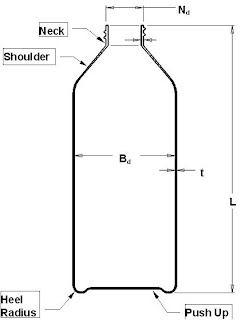Reduce Injection Velocity
Keeping the injection velocity low will reduce the shear that occurs in the material. Shear is a major factor affecting overheating of the material and I.V. reduction, therefore reducing velocity will protect the PET resin from excessive damage.
When working with hot preform method, the injection velocity will also make a significant difference to the material distribution in the finished container. Filling slower means that the preform will be hotter when the mold opens and its temperature balance will also have changed. Typically, the shoulder area will become relatively hotter than the base area giving more stretch at the top of the preform.
Excessive injection velocity can also disturb the alignment of the injection core, especially if the design is long and thin.
Reducing the injection velocity will also have the effect of making the holding time shorter since the V/P time will increase.
When working with warm / cool / cold preform method the temperature related effects are either greatly reduced or non-existent.
Oil flow into the injection cylinder must be reduced.
For machines fitted with electronic injection control, reduce the velocity percentage value on the injection screen of the electronic injection control system. Minimum usable value is typically around 15~17% but beware of making a short shot at very low settings.
For machines without electronic injection control, reduce the setting of the valve found on the operator side of the injection unit. Beware of making a short shot at very low settings.
In most cases, the five steps of injection control can be set to the same value. Different values may be advantageous in cases of complicated preform design or technically difficult bottles.
Reducing the injection velocity too far may cause other preform defects such as specks of crystal in the gate area.
When working with hot preform method, the injection velocity will also make a significant difference to the material distribution in the finished container. Filling slower means that the preform will be hotter when the mold opens and its temperature balance will also have changed. Typically, the shoulder area will become relatively hotter than the base area giving more stretch at the top of the preform.
Excessive injection velocity can also disturb the alignment of the injection core, especially if the design is long and thin.
Reducing the injection velocity will also have the effect of making the holding time shorter since the V/P time will increase.
When working with warm / cool / cold preform method the temperature related effects are either greatly reduced or non-existent.
Oil flow into the injection cylinder must be reduced.
For machines fitted with electronic injection control, reduce the velocity percentage value on the injection screen of the electronic injection control system. Minimum usable value is typically around 15~17% but beware of making a short shot at very low settings.
For machines without electronic injection control, reduce the setting of the valve found on the operator side of the injection unit. Beware of making a short shot at very low settings.
In most cases, the five steps of injection control can be set to the same value. Different values may be advantageous in cases of complicated preform design or technically difficult bottles.
Reducing the injection velocity too far may cause other preform defects such as specks of crystal in the gate area.



Comments